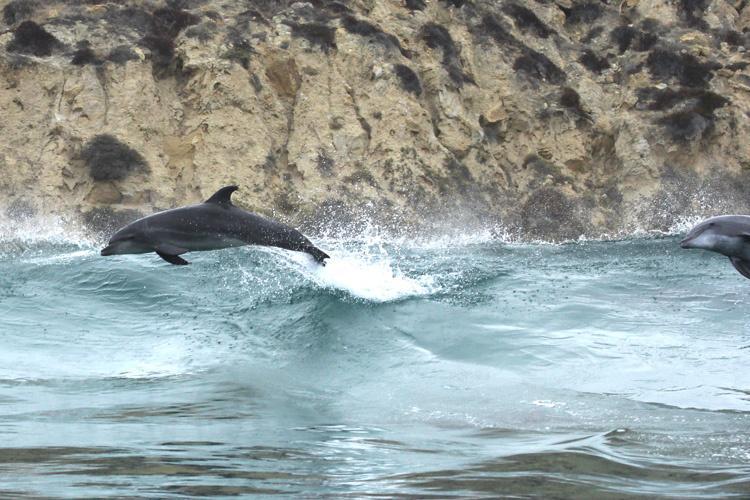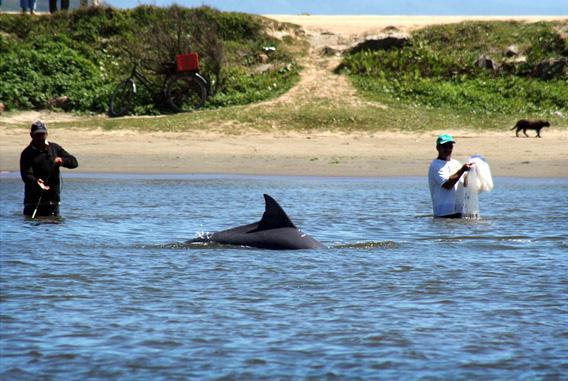Introduction
Bottlenose dolphins (Tursiops truncates) are known for their short, thick snouts. Most of them have a light gray to almost black color, which may be seen around their dorsal fin. A light gray to practically white can also be found on their belly (Australian Museum). There have been several studies on dolphin habitat usage in deep, narrow channels, but few have examined dolphin reactions to different habitats (Piwetz 2; Ranù et al. 2). This paper describes the natural habitat of the bluenose dolphin, along with the other species that it coexists with.
Bluenose Dolphin’s Natural Habitat
Depending on where they reside and what they consume, bottlenose dolphins may be found in a wide variety of habitats globally. The temperate and tropical oceans of the world are home to bottlenose dolphins (NOAAA Fisheries). It is possible to find them in a variety of environments, such as ports, bays, gulfs, and estuaries, as well as coastal waters nearshore and farther out to the sea (see fig. 1).

Natural and mechanically dredged rivers with an abundance of fish food or fish aggregation are frequent habitats for coastal marine mammal species (Piwetz 1). Dredged channels built to accommodate large ships are also homes for dolphins. Bluenose coexists with other animals in such habitats.
Other Things Existing in the Habitat
Bottlenose dolphins may be found in a broad range of ocean environments, and the marine animals that cohabitate with them vary greatly (Bergsma). They live in the same habitat as jellyfish, seals, and humpback whales in the Atlantic Ocean. Bottlenose dolphins also live with otters, penguins, and sea lions in coexistence in the Pacific Ocean, which is also home to whale species, salmon and barracuda (Bergsma). Large plankton-eating whale sharks and dolphins swim together in the open ocean, and most of the shallow water is covered by coral reefs. The diversity of their natural habitat enables them to adapt to different environments globally.
The Global Availability of Habitat
The bluenose dolphin’s habitat is abundant globally, particularly in tropical and warm-temperate regions. On the American continent, bottlenose dolphins can be seen along California’s southern beaches and the eastern seaboard from Massachusetts to Florida, and even further afield in the Caribbean Sea and the Gulf of Mexico (NOAAA Fisheries). A wide variety of these species may be observed in both the Atlantic and Pacific seas. They can be found in Norway and Nova Scotia all the way down to South Africa. In places like Hawaii, bottlenose dolphins can be spotted in the open ocean (Self et al. 2). As they are found globally, it is important to explore how they live in different habitats.
Life in Different Habitats
The bluenose dolphin is not restricted to any specific habitat, as it is a naturally versatile animal. In tropical and warm-temperate regions, bottlenose dolphins (genus Tursiops) can be found in coastal and pelagic populations (Piwetz 1). Both the Indo-Pacific bottlenose dolphin (T. aduncus) and the common bottlenose dolphin (T. truncatus) are found in Australia (Piwetz 2). T. truncatus has also been located in the eastern North Atlantic Ocean. In addition, T. truncatus and T. aduncus can be found in South Africa (King et al. 1). There are large populations of T. truncatus across the eastern Pacific Ocean, including the cold and warm temperate and tropical zones. This species can also be found in the middle Pacific (Hawaii) and westward to Japan (Piwetz 2). Owing to their high versatility, it is necessary to identify how they get their energy.
How Bottlenose Dolphins Get Energy
The diets of coastal and offshore organisms are distinct. A variety of shellfish, including squid, are consumed by South African Indo-Pacific bottlenose dolphins (Ranù et al. 2). Atlantic bottlenose dolphins consume a variety of fish and crustaceans. Even though bottlenose dolphins are known to feed alone, they are an exceptionally sociable species that gather around each other to consume their food (Australian Museum). If dolphins come together in large groups, they may catch schools of fish or squids by clustering them together and diving towards the center (Lauderdale et al. 13). The usage of sea sponges as tools, which appears to represent a separate cultural practice, helps females form bonds with each other (Mann and Karniski 624). To defend the females, several first-order alliances form teams (King et al. 1). Defense is critical when they encounter a predator. At this point, it is important to figure out what kinds of predators they face.
Bottlenose Dolphins’ Predators and Competitors
Bottlenose dolphins are preyed upon by a variety of shark species, including the bull shark (Carcharhinus leucas), the dusky shark (Carcharhinus obscurus), the tiger shark (Galeocerdo cuvier), and the great white shark (Carcharodon Carcharias). In addition to tiger, dusky, bull, and great white sharks, several other natural predators may be found in the ocean (Wilson). Shark bites scar at least 31% of the dolphins in Sarasota Bay, Florida. Killer whales (Orcinus orca) occasionally hunt bottlenose dolphins, although confirmed cases are rare (Heithaus 5). Dolphin mortality has also been connected to stingray poisoning, which causes death. Nevertheless, some species depend on the bluenose dolphin.
Species that Depend on Bottlenose Dolphins
Humans are the major dependents on the bluenose dolphin. Aside from the fact that little is known about their interactions, the benefits appear to be mutually beneficial. Both humans and dolphins must work together to obtain and share a common prey item. The two engage in cooperative foraging (Kownacki). Certain dolphin populations have adjusted their behavioral responses to take advantage of the feeding opportunities enabled by human commercial fisheries, leading to forms of mutualism (Ranù et al. 2). This is typical along the coast of Brazil (see fig.2). As a result, bottlenose dolphins use less energy in their search for food when fishing boats are nearby. Like bottlenose dolphins, people who fish for dolphins, have a big impact on their behavior and use (Rosa 2).

As a result, when dolphins exist in the area, fishermen benefit because they catch more fish, and they presumably gain as well (Ranù et al. 2; Rosa 2). The dolphin population’s spatial distribution, social behavior, auditory behavior, and population dynamics are all affected by this link.
Conclusion
The bottlenose dolphin’s natural behavior has been extensively researched. Bottlenose dolphins may be found in a wide range of environments in tropical and warm-temperate regions across the world, depending on where they live and what they eat. Food is critical when it comes to where bottlenose dolphins can live and how they get their energy.
Works Cited
Australian Museum. Bottlenose Dolphin. 2020.
Bergsma, Randi. “Animals That Live in the Bottlenose Dolphin’s Habitat.”Sciencig, 2019.
da Rosa, Daiane, et al. “The Ability of Artisanal Fishers to Recognize the Dolphins they Cooperate with.” Journal of Ethnobiology and Ethnomedicine, vol 16, no 30, 2020, pp. 1-17.
Heithaus, Michael, et al. “Spatial Variation in Shark-Inflicted Injuries to Indo-Pacific Bottlenose Dolphins of the Southwestern Indian Ocean.” Marine Mammal Science, vol 1, no 1, 2017. pp. 1-7.
King, Stephanie, et al. “Cooperation-Based Concept Formation in Male Bottlenose Dolphins.” Nature Communications, vol 12, no 2373, 2021, pp. 1-12.
Kownacki, Alexa. “Cooperative Fishing: Symbiotic Relationships between People and Dolphins.”Geospatial Ecology of Marine Megafauna Laboratory, 2020.
Lauderdale, Lisa, et al. “Habitat Characteristics and Animal Management Factors Associated with Habitat Use by Bottlenose Dolphins in Zoological Environments.” PLoS ONE, 16(8), 2021, pp. 1-17.
Mann, Janet and Caitlin Karniski. “Diving Beneath the Surface: Long-Term Studies of Dolphins and Whales.” Journal of Mammalogy, vol 98, no 3, 2017, pp. 621–630.
NOAAA Fisheries. Common Bottlenose Dolphin. 2022.
Piwetz, Sarah. “Common Bottlenose Dolphin (Tursiops Truncatus) Behavior in an Active Narrow Seaport.” PLoS ONE, vol. 14, no 2, 2019, pp. 1-23.
Ranù, Marco, et al. “Bottlenose Dolphins and Seabirds Distribution Analysis for the Identification of a Marine Biodiversity Hotspot in Agrigento Waters.” Journal of Marine Science and Engineering, vol 10, no. 345, 2022, pp. 1-22.
Self, Holly, et al. “Tourism Informing Conservation: The Distribution of Four Dolphin Species Varies with Calf Presence and Increases their Vulnerability to Vessel Traffic In The Four-Island Region Of Maui, Hawai‘I.” Ecological Solutions and Evidence, vol 2, no 2, 2021, pp. 1-18.
Wilson, Michael. Are Dolphins Predators of Sharks? Restaurant Norman, 2019.